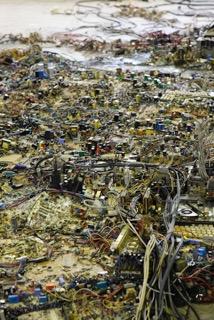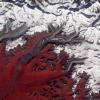Blog posts
Posts
A Hackers Manifesto, verze 4.0, kapitola 4.
By samotar, 10 January 2023
Alfred ve dvoře čili Poznámka k pražské hetero-utopii
By samotar, 10 November 2022
Trnovou korunou a tankem do srdíčka
By samotar, 2 July 2022
Hakim Bey - Informační válka
By samotar, 26 March 2022
Jean-Pierre Dupuy: Do we shape technologies, or do they shape us?
By samotar, 6 March 2022
Václav Cílek: Záhada zpívající houby
By samotar, 15 February 2022
Guy Debord - Teorie dérive
By samotar, 21 January 2022
Jack Burnham – Systémová estetika
By samotar, 19 November 2021
Poznámka pod čarou k výstavě Handa Gote: Věc, nástroj, čas, fetiš, hygiena, tabu
By samotar, 13 July 2021
Rána po ránech
By samotar, 23 May 2021
Na dohled od bronzového jezdce
By samotar, 4 March 2021
Z archivu:Mlha - ticho - temnota a bílé díry
By samotar, 7 October 2020
Zarchivu: Hůlna-kejdže
By samotar, 7 September 2020
Center for Land Use Interpretation
By samotar, 18 June 2020
Dawn Chorus Day - zvuky za svítání
By samotar, 30 April 2020
Z archivu: Bílé Břehy 2012 a Liběchov 2011
By , 3 April 2020
Z archivu: Krzysztof Wodiczko v DOXU
By samotar, 26 March 2020
GARY SNYDER: WRITERS AND THE WAR AGAINST NATURE
By samotar, 20 March 2020
Podoby domova: hnízda, nory, doupata, pavučiny, domestikace a ekologie
By samotar, 17 March 2020
Michel Serres: Transdisciplinarity as Relative Exteriority
By samotar, 5 November 2019
Pavel Ctibor: Sahat zakázáno
By samotar, 22 September 2019
Emmanuel Lévinas: HEIDEGGER, GAGARIN A MY
By samotar, 19 September 2019
Atmosférické poruchy / Atmospheric Disturbances - Ustí nad Labem
By samotar, 13 September 2019
Erkka Laininen: A Radical Vision of the Future School
By samotar, 10 August 2019
Anton Pannekoek: The Destruction of Nature (1909)
By samotar, 21 July 2019
Co padá shůry - světlo, pelyněk, oheň a šrot
By samotar, 30 December 2018
2000 slov v čase klimatických změn - manifest
By samotar, 2 November 2018
Vladimír Úlehla, sucho, geoinženýrství, endokrinologie, ekologie a Josef Charvát
By samotář, 22 September 2018
Lukáš Likavčan: Thermodynamics of Necrocracy - SUVs, entropy, and contingency management
By samotar, 20 July 2018
Tajemství spolupráce: Miloš Šejn
By samotar, 27 June 2018
Invisible Images (Your Pictures Are Looking at You) Trevor Paglen
By samotar, 2 June 2018
KŘEST KNIHY KRAJINA V POZORU: THE LANDSCAPE IN FOCUS.
By samotar, 18 May 2018
Případ zchudlé planety:Vojtěch Kotecký
By samotar, 22 April 2018
Rozhovor na Vltavě: Jak umění reaguje na dobu antropocénu?
By samotar, 10 March 2018
Skolt Sámi Path to Climate Change Resilience
By samotar, 10 December 2017
Brian Holmes: Driving the Golden Spike - The Aesthetics of Anthropocene Public Space
By samotar, 22 November 2017
Ohlédnutí/Revisited Soundworm Gathering
By samotař, 9 October 2017
Kleté krajiny
By samotar, 7 October 2017
Kinterova Jednotka a postnatura
By samotař, 15 September 2017
Ruiny-Černý trojúhelník a Koudelkův pohyb v saturnských kruzích
By samotar, 13 July 2017
Upsych316a Universal Psychiatric Church
By Samotar, 6 July 2017
Miloš Vojtěchovský: Krátká rozprava o místě z roku 1994
By milos, 31 May 2017
Za teorií poznání (radostný nekrolog), Bohuslav Blažek
By miloš vojtěchovský, 9 April 2017
On the Transmutation of Species
By miloš vojtěchovský, 27 March 2017
Gustav Metzger: Poznámky ke krizi v technologickém umění
By samotař, 2 March 2017
CYBERPOSITIVE, Sadie Plant a Nick Land
By samotař, 2 March 2017
Ivan Illich: Ticho jako obecní statek
By samotař, 18 February 2017
Dialog o primitivismu – Lawrence Jarach a John Zerzan
By samotar, 29 December 2016
Thomas Berry:Ekozoická éra
By samotař, 8 December 2016
Jason W. Moore: Name the System! Anthropocenes & the Capitalocene Alternative
By miloš vojtěchovský, 24 November 2016
Michel Serres: Revisiting The Natural Contract
By samotař, 11 November 2016
Best a Basta době uhelné
By samotař, 31 October 2016
Epifanie, krajina a poslední člověk/Epiphany, Landscape and Last Man
By Samotar, 20 October 2016
Doba kamenná - (Ein, Eisen, Wittgen, Frankenstein), doba plastová a temná mineralogie
By samotař, 4 October 2016
Hledání hlasu řeky Bíliny
By samotař, 23 September 2016
Harrisons: A MANIFESTO FOR THE 21ST CENTURY
By , 19 September 2016
T.J. Demos: Anthropocene, Capitalocene, Gynocene: The Many Names of Resistance
By , 11 September 2016
Bratrstvo
By samotař, 1 September 2016
Neptunismus a plutonismus na vyhaslé sopce Bořeň
By , 14 August 2016
Murray Bookchin: Toward an Ecological Society/ K ekologické společnosti (1974)
By samotař, 31 July 2016
Metafory, endofyzika, manželé Themersonovi a Gordon Pask
By samotař, 15 July 2016
Anima Mundi Revisited
By miloš vojtěchovský, 28 June 2016
Simon A. Levin: The Evolution of Ecology
By samotař, 21 June 2016
Anna Remešová: Je možné představit si změnu?
By samotar, 20 June 2016
Jan Hloušek: Uranové město
By samotař, 31 May 2016
Josef Šmajs: Složí lidstvo zkoušku své racionální dospělosti?
By samotař, 20 May 2016
Manifest The Dark Mountain Project
By Samotar, 3 May 2016
Pokus o popis jednoho zápasu
By samotar, 29 April 2016
Václav Cílek: Antropocén – velké zrychlení světa
By Slawomír Uher, 23 April 2016
Nothing worse or better can happen
By Ewa Jacobsson, 5 April 2016
Real Reason we Can’t Stop Global Warming: Saskia Sassen
By , 18 March 2016
The Political Economy of the Cultural Commons and the Nature of Sustainable Wealth
By samotar, 12 March 2016
Jared Diamond - Easter's End
By , 21 February 2016
Felix Guattari - Three Ecologies (part 1)
By , 19 February 2016
W. H. Auden: Journey to Iceland
By , 9 February 2016
Jussi Parikka: The Earth
By Slawomír Uher, 8 February 2016
Brian Holmes: Extradisciplinary Investigations. Towards a New Critique of Institutions
By Stanislaw, 7 February 2016
Co číhá za humny? neboli revoluce přítomnosti
By Miloš Vojtěchovský, 31 January 2016
Podivuhodný osud polárníka a malíře Julia Payera
By , 23 January 2016
Red Sky: The Eschatology of Trans
By Miloš Vojtěchovský, 19 January 2016
#AKCELERACIONISTICKÝ MANIFEST (14. května 2013)
By samotar, 7 January 2016
The Forgotten Space: Notes for a Film
By , 7 January 2016
Rise and Fall of the Herring Towns:Impacts of Climate and Human Teleconnections
By , 25 December 2015
Hlubinná, temná, světlá i povrchová ekologie světa
By , 22 December 2015
Three short movies: Baroque Duchcov, New Lakes of Mostecko and Lignite Clouds
By Michal Kindernay, 21 December 2015
Lenka Dolanová: Umění mediální ekologie
By , 21 December 2015
Towards an Anti-atlas of Borders
By , 20 December 2015
Pavel Mrkus - KINESIS, instalace Nejsvětější Salvátor
By Miloš Vojtěchovský, 6 December 2015
Tváře/Faces bez hranic/Sans Frontiers
By Miloš Vojtěchovský, 29 November 2015
Josef Šmajs: Ústava Země/A Constitution for the Earth
By Samotar, 28 November 2015
John Jordan: The Work of Art (and Activism) in the Age of the Anthropocene
By Samotar, 23 November 2015
Humoreska: kočky, koulení, hroby a špatná muška prince Josefa Saského
By Samotar, 13 November 2015
Rozhovor:Před věčným nic se katalogy nesčítají
By Samotar, 11 November 2015
Lecture by Dustin Breiting and Vít Bohal on Anthropocene
By Samotar, 8 November 2015
Antropocén a mocné žblunknutí/Anthropocene and the Mighty Plop
By Samotar, 2 November 2015
Rory Rowan:Extinction as Usual?Geo-Social Futures and Left Optimism
By Samotar, 27 October 2015
Pavel Klusák: Budoucnost smutné krajiny/The Future of a Sad Region
By ll, 19 October 2015
Na Zemi vzhůru nohama
By Alena Kotzmannová, 17 October 2015
Upside-down on Earth
By Alena Kotzmannová, 17 October 2015
Thomas Hylland Eriksen: What’s wrong with the Global North and the Global South?
By Samotar, 17 October 2015
Nýey and Borealis: Sonic Topologies by Nicolas Perret & Silvia Ploner
By Samotar, 12 October 2015
Images from Finnmark (Living Through the Landscape)
By Nicholas Norton, 12 October 2015
Bruno Latour: Love Your Monsters, Why We Must Care for Our Technologies As We Do Our Children
By John Dee, 11 October 2015
Temné objekty k obdivu: Edward Burtynsky, Mitch Epstein, Alex Maclean, Liam Young
By Samotar 10 October 2015, 10 October 2015
Czech Radio on Frontiers of Solitude
By Samotar, 10 October 2015
Beyond Time: orka, orka, orka, nečas, nečas, nečas
By Samotar, 10 October 2015
Langewiese and Newt or walking to Dlouhá louka
By Michal Kindernay, 7 October 2015
Notice in the Norwegian newspaper „Altaposten“
By Nicholas Norton, 5 October 2015
Interview with Ivar Smedstad
By Nicholas Norton, 5 October 2015
Iceland Expedition, Part 2
By Julia Martin, 4 October 2015
Closing at the Osek Monastery
By Michal Kindernay, 3 October 2015
Iceland Expedition, Part 1
By Julia Martin, 3 October 2015
Finnmarka a kopce / The Hills of Finnmark
By Vladimír Merta, 2 October 2015
Od kláštera Osek na Selesiovu výšinu, k Lomu, Libkovicům, Hrdlovce a zpět/From The Osek Cloister to Lom and back
By Samotar, 27 September 2015
Sápmelažžat Picnic and the Exploration of the Sami Lands and Culture
By Vladimir, 27 September 2015
Gardens of the Osek Monastery/Zahrady oseckého kláštera
By ll, 27 September 2015
Workshop with Radek Mikuláš/Dílna s Radkem Mikulášem
By Samotářka Dagmar, 26 September 2015
Czech Radio Interview Jan Klápště, Ivan Plicka and mayor of Horní Jiřetín Vladimír Buřt
By ll, 25 September 2015
Bořeň, zvuk a HNP/Bořeň, sound and Gross National Product
By Samotar, 25 September 2015
Já, Doly, Dolly a zemský ráj
By Samotar, 23 September 2015
Up to the Ore Mountains
By Michal, Dagmar a Helena Samotáři , 22 September 2015
Václav Cílek and the Sacred Landscape
By Samotář Michal, 22 September 2015
Picnic at the Ledvice waste pond
By Samotar, 19 September 2015
Above Jezeří Castle
By Samotar, 19 September 2015
Cancerous Land, part 3
By Tamás Sajó, 18 September 2015
Ledvice coal preparation plant
By Dominik Žižka, 18 September 2015
pod hladinou
By Dominik Žižka, 18 September 2015
Cancerous Land, part 2
By Tamás Sajó, 17 September 2015
Cancerous Land, part 1
By Tamás Sajó, 16 September 2015
Offroad trip
By Dominik Žižka, 16 September 2015
Ekologické limity a nutnost jejich prolomení
By Miloš Vojtěchovský, 16 September 2015
Lignite Clouds Sound Workshop: Days I and II
By Samotar, 15 September 2015
Recollection of Jezeří/Eisenberg Arboretum workshop
By Samotar, 14 September 2015
Walk from Mariánské Radčice
By Michal Kindernay, 12 September 2015
Mariánské Radčice and Libkovice
By Samotar, 11 September 2015
Tušimice II and The Vicarage, or the Parsonage at Mariánské Radčice
By Samotar, 10 September 2015
Most - Lake, Fish, algae bloom
By Samotar, 8 September 2015
Monday: Bílina open pit excursion
By Samotar, 7 September 2015
Duchcov II. - past and tomorrow
By Samotar, 6 September 2015
Duchcov II.
By Samotar, 6 September 2015
Arrival at Duchcov I.
By Samotar, 6 September 2015
Poznámka k havárii rypadla KU 300 (K severu 1)
By Samotar, 19 August 2015
On the Transmutation of Species
Today, there is an industrial mutation — a technological mutation — that’s taking place. New machines are appearing: cognitive machines, cultural machines, and now nanotechnologies. There are new processes of exteriorisation: Artificial Intelligence, the cell phone. … Until today, these technologies of exteriorization were limited to the world of Research and Development. Now, they are expanding into consumer society at large.
—Bernard Stiegler
From the vantage point of geological time it seems the moment had occurred just yesterday. Humanity awoke from a dreamtime and started learning more than just to observe: to construct, improve and dismantle sophisticated systems and visual apparatuses; to obtain, distinguish, scan, save, replicate, multiply and compare the images of the world and of the human from above, from a bird’s-eye view. Today the ever- expanding content of the imagosphere’s digital central archive contains terabytes of landscapes, close-ups, sketches, samples, portraits, self-portraits, but also images which are created autopoietically and without the active involvement of a human: the image database of stratigraphic, geo-morphological and geo-historical data and records.
Such archives also offer us both direct and circumstantial evidence. Apart from prehistoric images, we also find forensic documentation on the extinction of species — eschatological illustrations and whole files on the exploitation and colonization of the biosphere by the human. The screens and monitors clearly show the development of new tissues of informational networks, as well as the agglomerations which surround and connect our terrestrial cities. These archives also allow us to animate other processes of urbanization, and observe the changes in the planet’s color palette — the frontier between desert and vegetation, the melting of polar ice, and the development of sprawling industrial zones. We can observe the pulsing capillaries fed by the system’s obsessive compulsion to endlessly transfer resources, goods and nutrients, and to dig up and rearrange fossils and accelerate their metamorphosis into energy, heat and smog.
By means of satellite cameras and drones, people have claimed the surface of the Earth and have gained the ability to perceive the world from a bird’s-eye view. The art of objective distance transforms the appearance of our homes, changes our perception of planetary topography, and transforms space into a living map — a fragmented image complex compiled by immersive apparatuses of ever-present observation. The observation post is the avatar of today’s world — it is a metalab, a planetary dump where horizons open up onto distant space, and where contours and details are obfuscated by the granularity of LCD monitors and the electromagnetic noise of data.
Thanks to tools, the people of the 21st century see not only far, but also deep into physical matter, observing processes which their ancestors could only intuit. We can observe and study new natural and artificial formations and structures, circumscribe vast environments with meandering rivers and zones of lithium tailing ponds, seacoast fractals, cloud voyages, and networks constructed at a speed and scale never before seen. Man’s drive towards energy production has changed even the appearance of the Earth. As an image from Athanasius Kircher’s The Ecstatic Journey (Itinerarium Exstaticum, 1656, Rome), a visionary tale documenting a round-trip to the planets, electric plants and grids have obsolesced the rhythms of day and night and have illuminated vast continents, whose shining dendrites and fibres may be seen from outer space.
Humanity’s bird’s-eye view does not necessarily have to be spectacular, pleasant or entertaining. If we conquer our vertigo, we will often see scenery that is rather bleak or unsettling. Throughout the ages, people have largely remained hidden, prowling the bush and forests, mapping the immediate surroundings and the earth beneath their feet, while turning their eyes to the heavens. The starry sky has always been the primeval screen for projecting earthly anxieties; it was a stage for magical thinking, instances of pareidolia and evocations. The heavenly optics of the Anthropocene, however, offer views of complex systemic events and processes of which, until recently, we could detect only small details. We were either unaware of their wider existence, or did not ascribe any importance to them. Now, we are thrust into the roles of both observer and actor in planetary changes.
The Trees of Life
The era stretching from the medieval cosmologies to 19th-century positivist science was rife with attempts at abstracting a coherent system — a mental and descriptive visualization of reality — which fed the imagination of artists and the experimentation of natural scientists. Each period found and established some type of successful unifying diagram which corresponded to the vision, ideologies, situations, and scientific knowledge present at that specific time and place. In Darwin’s The Origin of Species (6th edition, 1872) we find the following paragraph (which was clearly inspired by a sketch from his B notebook Transmutation of Species, dated 1837):
The affinities of all beings of the same class have sometimes been represented by a great tree. I believe this simile largely speaks the truth. The green and budding twigs may represent existing species; and those produced during former years may represent the long succession of extinct species. … As buds give rise by growth to fresh buds, and these, if vigorous, branch out and overtop on all sides many a feebler branch, so by generation I believe it has been with the great Tree of Life, which fills with its dead and broken branches the crust of the earth, and covers the surface with its ever-branching and beautiful ramifications.
Ernst Haeckel, who was largely devoted to popularizing Darwin’s work, published a similarly — but much more “realistic” Darwinian diagram in his Evolution of Man in1866. It is a popular picture of a “phylogenetic” tree which further promulgated the idea of an evolutionary development of life and the taxa joined together are implied to have descended from a common ancestor. The roots of a grown oak, representing the emergence of life and the taxonomy of simple organisms (protozoa), branch upwards in a unitary gesture of development towards the genus, species and family. The branches shoot up towards more complex forms — plants, fungi, vertebrates, mammals — and the very pinnacle of God’s work is crowned by the “Kingdom of Man”.
The 20th century gradually developed and dispelled many of the outdated ideas and seemingly obsolete images of how humanity imagined the world. Some conceptions were embedded within the morphology and models of live matter which developed from still older constructs of natural science and religion. The colorful illustrated tableaux of marine life in Haeckel’s encyclopedias exhibit a fin-de-siècle aesthetic and have an affinity with the organic morphology of the Jugendstil. This neo-baroque filigree geometry of mysterious marine crustaceans was markedly popular towards the end of the 19th century. Later, it resonated with artists associated with Bauhaus, such as Paul Klee, as well as fermenting the imaginative unconscious of the Surrealists, and later still was an influence on Buckminster Fuller’s architectonic principle of Dymaxion. It was Donald B. Ingber, the director of the Wyss Institute for Biologically Inspired Engineering at Harvard University, who took up Buckminster Fuller’s and sculptor Kenneth Snelson’s concept of tensegrity (tensional integrity) which, in bionic architecture, forms the underlying concept of hierarchically organized and spatially regular organic structures. According to the theory the basic expression of organized living matter is its ability to resist gravity. The formation of firm organs, such as bones, tendons and muscles, is predicated on this tectonic principle of tension. The extracellular matrix organizes cells into tissue, and the cells adjust and retain their shape based on the cytoskeleton scaffolding which is manifest both at the macro and the micro, or molecular, scale.
The domain of machine and non-machine non-humans (the unhuman in my terminology) joins people in the building of the artifactual collective called nature. None of these actants can be considered as simply resource, ground, matrix, object, material, instrument, frozen labor; they are all more unsettling than that.
—The Promises of Monsters, Donna Haraway
This structural characteristic which attempts to find a homology between the micro and macro worlds, between different human and “unhuman” systems was also being developed in other disciplines. Around the middle of the previous century cybernetics, system theory, anthropology, and other social and natural sciences were proposing alternative models of basic biological and physical phenomena, such as open and mutually connected systems which strive to retain homeostasis by means of feedback loops and adaptation, thus resisting entropic processes. The concept of a ‘rhizomatic structure’ received much attention. This irregular and seemingly chaotic shape does not heed the determinacy of gravity, or hierarchical formations of growth and linearity.
Deleuze and Guattari borrowed the term ‘rhizome’ from biologist and cybernetician Gregory Bateson.They describe it as a symptom of heterogeneity; as a subversive alternative to the patriarchal archetype of the tree. Thus they expanded its relevance from the language of botany and natural sciences into fields such as linguistics, ideology and aesthetics:
We are tired of the tree. We must no longer put our faith in trees, roots, or radicals; we have suffered enough from them. The whole arborescent culture is founded on them, from biology to linguistics. On the contrary, only underground stems and aerial roots, the adventitious and the rhizome are truly beautiful, loving or political. [Deleuze & Guattari, Capitalism and Schizophrenia, 1983].
The rhizome is the determining shape of ginger, calamus and the potato plant, the shape of the labyrinthine system of paths and walls of the termite nest, silicon-based electronic and electric networks, moss, parasitic and symbiotic mycelia connected by trace elements in soil, tree roots and animal biotopes — all these are connected in one branching organism. Its propagators further ascribed to it an essential affinity with the postindustrial techno-culture typified by crumbling boundaries between the public and the private, biological and technological, organic and inorganic, and between the center and periphery. The rhizome is thus considered as a universal element, and a significant concept in natural, artificial, sublime, hermetic and non-linear figures. No organ is the ultimate beginning or end, nor is it the cause or effect. We cannot find axial symmetries, a center, or a periphery. The rhizomatic organism has a diffuse intelligence: everywhere it simultaneously moves, gives birth, grows and perishes. Consequently, this kind of evolution resembles a clump of roots that considers the occurrence of multiplicities. Emerging species grow from the rhizome with gene repertoires of various origins allowing the multiplication and perpetuation of this species. As such, new species and new genes are and will continuously appear.
Naturally, I had no way of controlling the form of what I was making: I just stayed there all huddled up, silent and sluggish, and I secreted. I went on even after the shell covered my whole body.
—Invisible Cities, Italo Calvino
We find rhizomes not only in the world of fungi, insects but also in moss and lichen. Lichens are able to penetrate into various substrates, and are most often found on rocks, in soil and as epiphytes growing on trees and bushes, comprising one part of a symbiotic community of fungi (a mycobiont) and algae or cyanobacteria (a photo- or phycobiont). Their relationships stretch from the mutually beneficial to the clearly parasitic. Their commensalism is predicated on the biological cohabitation between two organisms where one reaps benefits while the other remains unaffected. The model of allelopathy or antibiosis however, describes the relationship when one species of organism negatively affects its surroundings or other species by means of chemicals which it releases into the environment. Such an analogy offers an ominous model for the Anthropocene. The „natural history“ and new aesthetics of electronic fossils is indicative of the economies, cultures and ecologies of our time. Omnipresent digital debris penetrate as artificial lichens into geological subtrates and into bodies of living organism. Its rhizomatic structures are unfolding through minerals, chemicals, temporalities, soil, water, air.
Krištof Kintera’s “post-natural” works and installations are predicated upon the counterpoint of the sculpture’s rhizomatic anatomy with the orthogonal geometry of the aseptic gallery space. As if the toxic hardware virus crawling on the floor were affected by mutagenesis which shaped its sculpture-organisms’s biomorphic, yet inorganic body made of e-waste, digital debris, copper and silicone. The appearance remains enigmatic — perhaps the viewer is watching the remains of a symbiont’s exoskeleton, or an artifact from an unknown insectoid civilization, a model of post-apocalyptic architecture, or a fossil of a species from the electronic age.
Miloš Vojtěchovský, text for the catalogue of Kristof Kintera´s large installation POSTNATURLIA at the Colezione Maramotti, 2017, translation Vít Bohal


















